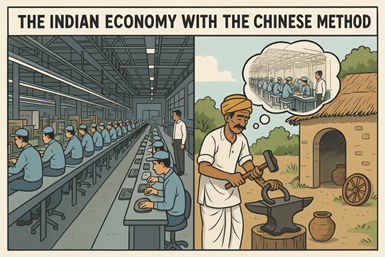



Prosperity is not a miracle—it’s a method. India’s next revolution must begin where China’s began: in the classroom, the workshop, and the district.
By Ravishankar Kalyanasundaram
India is set to become the third-largest economy by 2027, as our ministers remind us with swelling pride. By 2047, the nation aspires to be a developed economy. The optimism is not misplaced: GDP nearing $4 trillion, record exports, digital reach spanning 1.4 billion people, and a youthful workforce ready to take on the world.
We have wealth, wisdom, and the world’s largest rural heartland. What we lack is discipline of method — the continuity to convert ambition into action.
Free power, credit subsidies, and welfare transfers keep us afloat but not ascending. We celebrate schemes, not systems.
Prosperity rarely lands by chance. It arrives when education, skills, and logistics lock together—quietly, persistently—until a village becomes a workshop, a workshop becomes a cluster, and a cluster becomes a gateway to the world.
Let Us Look at China
When one surveys China’s transformation—from the sealed silence of the 1970s to the thunder of bullet trains—it feels impossible that a nation could move from famine to factories within two generations. Yet it was not magic. It was method.
This method built not one industry, not one province, but an entire economy—coherent, connected, and competitive. From shipyards to satellites, it was education aligned with production, and governance aligned with goals.
The Method Behind the Miracle
China’s rise began not with technology but with organisation. The first task was literacy — not in literature, but in labour. Deng Xiaoping called it “education for production.”
Universities were not the spearhead; polytechnics, shop-floor training, and field schools were. Industrial estates grew in step with technical institutes; townships paired employment with apprenticeship.
By the time foreign investment arrived in the 1980s, a semi-skilled, disciplined workforce stood ready. Where most nations separated education from enterprise, China braided them together. Every county became a mini-development agency, every industrial estate a learning hub.
From Workshops to World Brands
The world once dismissed China as a producer of cheap goods. Within decades, it became the workshop of the world — and then its brand house.
From Huawei and Haier to Lenovo and BYD, Chinese firms climbed the value chain with relentless focus. Huawei evolved from a small Shenzhen distributor to a 5G technology leader investing over 10% of its revenue in R&D.
Haier, once a failing refrigerator factory, became the world’s most trusted appliance brand through strict quality control and worker-led innovation.
BYD grew from a battery assembler into a global EV and lithium giant, now rivalling Tesla in production scale.
China’s dominance in solar panels, rare-earth processing, and lithium-ion batteries now defines the future of global energy. Few realise that even nuclear fuel reprocessing — a domain of scientific elite — sees India quietly partnering Chinese firms for facilities in Hyderabad.
This is not the land of toys anymore; this is a nation that manufactures mastery. It scaled industries, created technologies, and built global brands through method, not miracle.
An Observer’s Reflection
India, with its deeper global history, could have been the natural leader in this story. We have partnered MNCs for centuries — from textiles to telecommunication — yet we do not have a single global consumer brand in automobiles, electronics, watches, razors, or shoes.
We are the largest producer of food grains in the world, yet struggle to build modern silos and storage systems. In contrast, China has world-class food storage complexes and the largest silo-making companies. They built their grain logistics with precision and scale; we are still debating procurement losses.
This is not a question of capability — it is a question of priorities. We have intellect, but not integration; talent, but not timelines. Our systems aim to please everyone instead of performing for anyone.
Unlocking the Gold Mine of Rural India
If India’s rural economy were a country, it would be among the world’s top ten by population and potential. It is young, energetic, and underutilised. The world’s supply chains are fracturing, moving toward “friend-shoring.” Rural India can be the trusted workshop of this new order — if we learn to link education, enterprise, and execution.
We must:
The Chinese lesson is not authoritarianism — it is administrative coherence, a chain that runs unbroken from classroom to container terminal.
A Closing Thought
China’s success shows that prosperity is engineered, not imagined.
India can reach the same heights if it replaces slogans with systems, schemes with structures, and rhetoric with results.
We have the talent, the technology, and the trust of the world. What we need now is the discipline to deliver — the Chinese method, applied with Indian soul.
If we align our spirit of enterprise with their culture of execution, our villages will not just vote — they will produce, innovate, and export.
Prosperity is never an accident. It is a sequence — education, skills, infrastructure, and order — turning potential into power and the ordinary into the exceptional.